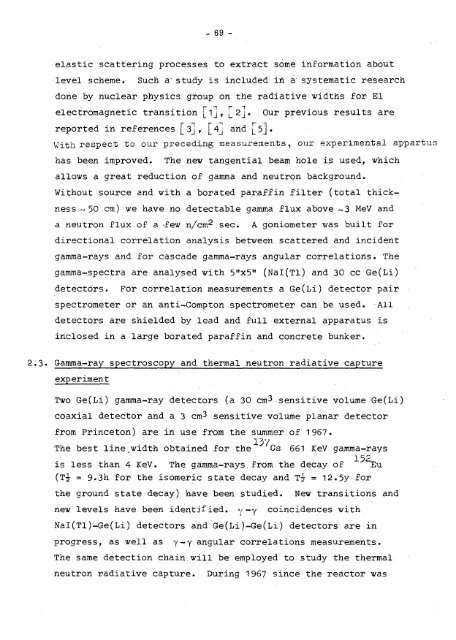1 - IAEA Nuclear Data Services
1 - IAEA Nuclear Data Services
1 - IAEA Nuclear Data Services
Create successful ePaper yourself
Turn your PDF publications into a flip-book with our unique Google optimized e-Paper software.
- 69 -<br />
elastic scattering processes to extract some information about<br />
level scheme. Such a study is included iñá systematic research<br />
done by nuclear physics group on the radiative widths for El<br />
electromagnetic transition j_1j» ¡_ 2 i* ® nr previous results are<br />
reported in references [ 3] ,• [ 4j and j_ 5] •<br />
With respect to our preceding measurements, our experimental appartus<br />
has been improved. The new tangential beam hole is used, which<br />
allows a great reduction of gamma and neutron background.<br />
Without source and with a borated paraffin filter (total thick<br />
ness -50 cm) we have no detectable gamma flux above ~3 MeV and<br />
a neutron flux of a -few n/cm 2 sec. A goniometer was built for<br />
directional correlation analysis between scattered and incident<br />
gamma-rays and for cascade gamma-rays angular correlations. The<br />
gamma-spectra are analysed with 5"x5" (Nal(Tl) and 30 cc Ge(Li)<br />
detectors. For correlation measurements a Ge(Li) detector pair<br />
spectrometer or an anti-Compton spectrometer can be used. All<br />
detectors are shielded by lead and full external apparatus is<br />
inclosed in a large borated paraffin and concrete bunker.<br />
Gamma-ray spectroscopy and thermal neutron radiative capture<br />
experiment<br />
Two Ge(Li) gamma-ray detectors (a 30 cm3 sensitive volume Ge(Li)<br />
coaxial detector and a 3 cm3 sensitive volume planar detector<br />
from Princeton) are in use from the summer of 1967.<br />
137<br />
The best line,width obtained for the Cs 661 KeV gamma-rays<br />
152<br />
is less than 4 KeV. The gamma-rays. from the decay of Eu<br />
(T¿ = 9.3h for the isomeric state decay and T-§-' = 12.5y for<br />
the ground state decay) have been studied. New transitions and<br />
new levels have been identified, y-y coincidences with<br />
Nal(Tl)-Ge(Li) detectors and Ge(Li)-Ge(Li) detectors are in<br />
progress, as well as y~Y angular correlations measurements.<br />
The same detection chain.will be employed to study the thermal<br />
neutron radiative capture. During 1967 since the reactor was
















